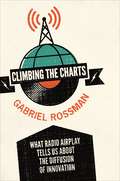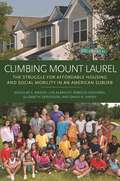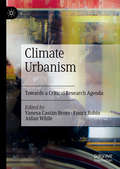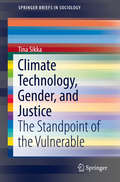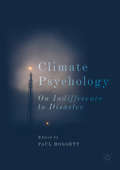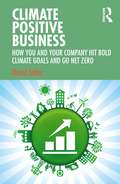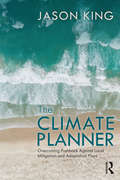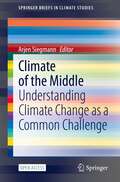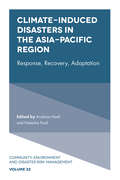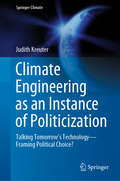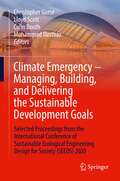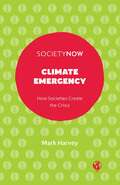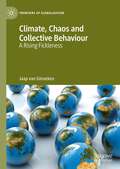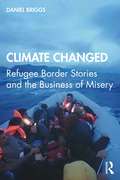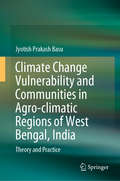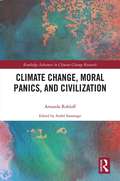- Table View
- List View
Clinical Applications of Linguistics to Speech-Language Pathology: A Guide for Clinicians
by Naomi Gurevich Christopher M. GrindrodClinical Applications of Linguistics to Speech-Language Pathology is a practical guide that provides linguistically grounded approaches to clinical practice. It introduces key linguistic disciplines and discusses how they form a basis for assessment and treatment of individuals with communication differences or disorders. Written by experts in linguistics and communication disorders, each chapter provides clinicians with a foundational understanding of linguistics as it applies to spoken and signed languages and underscores the importance of integrating linguistic theories into clinical decision-making. The book is divided into two parts that focus on the applications of linguistics to speech and language differences and disorders in both children and adults. The chapters cover the full range of linguistic domains including phonetics, phonology, morphology, syntax, semantics, pragmatics, and sociolinguistics. Applications to a wide range of populations including childhood apraxia of speech, aphasia, dysarthria, traumatic brain injury and accent modification clients are also discussed. Many chapters include assessment and treatment resources that can be used by practicing clinicians. This highly accessible and comprehensive book is an indispensable resource for practicing speech-language pathologists and other members of the profession, including instructors with minimal exposure to linguistics. It will also be beneficial for students of Linguistics, Speech and Hearing Sciences, and Audiology and Speech Language Pathology who are seeking practical knowledge of the fields.
Climbing the Charts: What Radio Airplay Tells Us about the Diffusion of Innovation
by Gabriel RossmanDespite the growth of digital media, traditional FM radio airplay still remains the essential way for musicians to achieve commercial success. Climbing the Charts examines how songs rise, or fail to rise, up the radio airplay charts. Looking at the relationships between record labels, tastemakers, and the public, Gabriel Rossman develops a clear picture of the roles of key players and the gatekeeping mechanisms in the commercial music industry. Along the way, he explores its massive inequalities, debunks many popular misconceptions about radio stations' abilities to dictate hits, and shows how a song diffuses throughout the nation to become a massive success. Contrary to the common belief that Clear Channel sees every sparrow that falls, Rossman demonstrates that corporate radio chains neither micromanage the routine decision of when to start playing a new single nor make top-down decisions to blacklist such politically inconvenient artists as the Dixie Chicks. Neither do stations imitate either ordinary peers or the so-called kingmaker radio stations who are wrongly believed to be able to make or break a single. Instead, Rossman shows that hits spread rapidly across radio because they clearly conform to an identifiable style or genre. Radio stations respond to these songs, and major labels put their money behind them through extensive marketing and promotion efforts, including the illegal yet time-honored practice of payoffs known within the industry as payola. Climbing the Charts provides a fresh take on the music industry and a model for understanding the diffusion of innovation.
Climbing the Charts: What Radio Airplay Tells Us about the Diffusion of Innovation (PDF)
by Gabriel RossmanDespite the growth of digital media, traditional FM radio airplay still remains the essential way for musicians to achieve commercial success. Climbing the Charts examines how songs rise, or fail to rise, up the radio airplay charts. Looking at the relationships between record labels, tastemakers, and the public, Gabriel Rossman develops a clear picture of the roles of key players and the gatekeeping mechanisms in the commercial music industry. Along the way, he explores its massive inequalities, debunks many popular misconceptions about radio stations' abilities to dictate hits, and shows how a song diffuses throughout the nation to become a massive success. Contrary to the common belief that Clear Channel sees every sparrow that falls, Rossman demonstrates that corporate radio chains neither micromanage the routine decision of when to start playing a new single nor make top-down decisions to blacklist such politically inconvenient artists as the Dixie Chicks. Neither do stations imitate either ordinary peers or the so-called kingmaker radio stations who are wrongly believed to be able to make or break a single. Instead, Rossman shows that hits spread rapidly across radio because they clearly conform to an identifiable style or genre. Radio stations respond to these songs, and major labels put their money behind them through extensive marketing and promotion efforts, including the illegal yet time-honored practice of payoffs known within the industry as payola. Climbing the Charts provides a fresh take on the music industry and a model for understanding the diffusion of innovation.
Climbing Mount Laurel: The Struggle for Affordable Housing and Social Mobility in an American Suburb
by Douglas S. Massey Len Albright Rebecca Casciano Elizabeth Derickson David N. KinseyUnder the New Jersey State Constitution as interpreted by the State Supreme Court in 1975 and 1983, municipalities are required to use their zoning authority to create realistic opportunities for a fair share of affordable housing for low- and moderate-income households. Mount Laurel was the town at the center of the court decisions. As a result, Mount Laurel has become synonymous with the debate over affordable housing policy designed to create economically integrated communities. What was the impact of the Mount Laurel decision on those most affected by it? What does the case tell us about economic inequality?Climbing Mount Laurel undertakes a systematic evaluation of the Ethel Lawrence Homes--a housing development produced as a result of the Mount Laurel decision. Douglas Massey and his colleagues assess the consequences for the surrounding neighborhoods and their inhabitants, the township of Mount Laurel, and the residents of the Ethel Lawrence Homes. Their analysis reveals what social scientists call neighborhood effects--the notion that neighborhoods can shape the life trajectories of their inhabitants. Climbing Mount Laurel proves that the building of affordable housing projects is an efficacious, cost-effective approach to integration and improving the lives of the poor, with reasonable cost and no drawbacks for the community at large.
Climbing Mount Laurel: The Struggle for Affordable Housing and Social Mobility in an American Suburb (PDF)
by Douglas S. Massey Len Albright Rebecca Casciano Elizabeth Derickson David N. KinseyUnder the New Jersey State Constitution as interpreted by the State Supreme Court in 1975 and 1983, municipalities are required to use their zoning authority to create realistic opportunities for a fair share of affordable housing for low- and moderate-income households. Mount Laurel was the town at the center of the court decisions. As a result, Mount Laurel has become synonymous with the debate over affordable housing policy designed to create economically integrated communities. What was the impact of the Mount Laurel decision on those most affected by it? What does the case tell us about economic inequality?Climbing Mount Laurel undertakes a systematic evaluation of the Ethel Lawrence Homes--a housing development produced as a result of the Mount Laurel decision. Douglas Massey and his colleagues assess the consequences for the surrounding neighborhoods and their inhabitants, the township of Mount Laurel, and the residents of the Ethel Lawrence Homes. Their analysis reveals what social scientists call neighborhood effects--the notion that neighborhoods can shape the life trajectories of their inhabitants. Climbing Mount Laurel proves that the building of affordable housing projects is an efficacious, cost-effective approach to integration and improving the lives of the poor, with reasonable cost and no drawbacks for the community at large.
Climate Urbanism: Towards a Critical Research Agenda
by Vanesa Castán Broto Enora Robin Aidan WhileThis book argues that the relationship between cities and climate change is entering a new and more urgent phase. Thirteen contributions from a range of leading scholars explore the need to rethink and reorient urban life in response to climatic change. Split into four parts it begins by asking ‘What is climate urbanism?’ and exploring key features from different locations and epistemological traditions. The second section examines the transformative potential of climate urbanism to challenge social and environmental injustices within and between cities. In the third part authors interrogate current knowledge paradigms underpinning climate and urban science and how they shape contemporary urban trajectories. The final section focuses on the future, envisaging climate urbanism as a new communal project, and focuses on the role of citizens and non-state actors in driving transformative action. Consolidating debates on climate urbanism, the book highlights the opportunities and tensions of urban environmental policy, providing a framework for researchers and practitioners to respond to the urban challenges of a radically climate-changed world.
Climate Technology, Gender, and Justice: The Standpoint Of The Vulnerable (Springerbriefs In Sociology Ser.)
by Tina SikkaThis book is the first to undertake a gendered analysis of geoengineering and alternative energy sources. Are either of these technologies sufficiently attendant to gender issues? Do they incorporate feminist values as articulated by the renowned social philosopher Helen Longino, such as empirical adequacy, novelty, heterogeneity, complexity and applicability to human needs? The overarching argument in this book contends that, while mitigation strategies like solar and wind energy go much further to meet feminist objectives and virtues, geoengineering is not consistent with the values of justice as articulated in Longino's feminist approach to science. This book provides a novel, feminist argument in support of pursuing alternative energy in the place of geoengineering. It provides an invaluable contribution for academics and students working in the areas of gender, science and climate change as well as policy makers interested in innovative ways of taking up climate change mitigation and gender.
Climate Psychology: On Indifference to Disaster (Studies in the Psychosocial)
by Paul HoggettThis book investigates the psycho-social phenomenon which is society’s failure to respond to climate change. It analyses the non-rational dimensions of our collective paralysis in the face of worsening climate change and environmental destruction, exploring the emotional, ethical, social, organizational and cultural dynamics to blame for this global lack of action. The book features eleven research projects from four different countries and is divided in two parts, the first highlighting novel methodologies, the second presenting new findings. Contributors to the first part show how a ‘deep listening’ approach to research can reveal the anxieties, tensions, contradictions, frames and narratives that contribute to people’s experiences, and the many ways climate change and other environmental risks are imagined through metaphor, imagery and dreams. Using detailed interview extracts drawn from politicians, scientists and activists as well as ordinary people, the second part of the book examines the many different ways in which we both avoid and square up to this gathering disaster, and the many faces of alarm, outrage, denial and indifference this involves.
Climate Protection, Resource Efficiency, and Sustainable Engineering: Transdisciplinary Approaches to Design and Manufacturing Technology (Science Studies)
by Ilona Horwath Swetlana SchweizerThe big societal challenges, such as climate change and public health, call for innovative approaches to address them. The contributors of this book present new ways to tackle these challenges by inter- and transdisciplinary collaborations in light weight engineering. They introduce a framework for transdisciplinary collaboration, explore the potential of light weight engineering in the areas of climate protection, resource efficiency, and sustainable mobility. To do so, they exemplify results and limitations of transdisciplinary collaboration based on three case studies: the optimization of rescue tools, the re-design of products to foster re-use and recycling processes in companies and society, and the additive manufacturing of individualized assistive tools and prostheses.
Climate Positive Business: How You and Your Company Hit Bold Climate Goals and Go Net Zero
by David JaberThis is the decade for climate action. Internal and external stakeholders demand action. How we choose to act in the next ten years will determine our foreseeable future. Businesses hold a critical role for climate futures. The need for businesses to reduce their carbon footprint is now unquestioned, but how to achieve reductions in a credible way is neither clear nor easy once you’ve tackled the obvious energy culprits. Climate Positive Business lays out the path of business climate strategy, highlighting how your business must set goals, measure impact, and improve performance. Greenhouse gas protocols can instruct you on the core accounting process that lies at the heart of climate strategy. At least as important to success are the details that protocols don’t tell you: the sticking points; the areas of controversy, and the best practices. Rooted in real experience and written in an entertaining and engaging style, this book provides you with the tips, tools, and techniques to tackle your company’s carbon footprint, and it helps you do so in a way that is credible and appropriately ambitious to meet stakeholder expectations. The book will equip you with tools to think critically about GHG reduction, carbon offsets, and carbon removal, as well as help ensure we collectively implement real solutions to slow and eventually reverse the climate crisis. It includes lessons learned from real-world consulting projects and provides a plan of action for readers to implement. A go-to book for business looking to understand, manage, and reduce their carbon footprint, it is an invaluable resource for sustainable business practitioners, consultants, and those aspiring to become climate champions.
Climate Positive Business: How You and Your Company Hit Bold Climate Goals and Go Net Zero
by David JaberThis is the decade for climate action. Internal and external stakeholders demand action. How we choose to act in the next ten years will determine our foreseeable future. Businesses hold a critical role for climate futures. The need for businesses to reduce their carbon footprint is now unquestioned, but how to achieve reductions in a credible way is neither clear nor easy once you’ve tackled the obvious energy culprits. Climate Positive Business lays out the path of business climate strategy, highlighting how your business must set goals, measure impact, and improve performance. Greenhouse gas protocols can instruct you on the core accounting process that lies at the heart of climate strategy. At least as important to success are the details that protocols don’t tell you: the sticking points; the areas of controversy, and the best practices. Rooted in real experience and written in an entertaining and engaging style, this book provides you with the tips, tools, and techniques to tackle your company’s carbon footprint, and it helps you do so in a way that is credible and appropriately ambitious to meet stakeholder expectations. The book will equip you with tools to think critically about GHG reduction, carbon offsets, and carbon removal, as well as help ensure we collectively implement real solutions to slow and eventually reverse the climate crisis. It includes lessons learned from real-world consulting projects and provides a plan of action for readers to implement. A go-to book for business looking to understand, manage, and reduce their carbon footprint, it is an invaluable resource for sustainable business practitioners, consultants, and those aspiring to become climate champions.
The Climate Planner: Overcoming Pushback Against Local Mitigation and Adaptation Plans
by Jason KingThe Climate Planner is about overcoming the objections to climate change mitigation and adaption that urban planners face at a local level. It shows how to draft climate plans that encounter less resistance because they involve the public, stakeholders, and decisionmakers in a way that builds trust, creates consensus, and leads to implementation. Although focused on the local level, this book discusses climate basics such as carbon dioxide levels in the atmosphere, the Intergovernmental Panel on Climate Change, the Paris Agreement of 2015, worldwide energy generation forecasts, and other items of global concern in order to familiarize urban planners and citizen planners with key concepts that they will need to know in order to be able to host climate conversations at the local level. The many case studies from around the United States of America show how communities have encountered pushback and bridged the implementation gap, the gap between plan and reality, thanks to a commitment to substantive public engagement. The book is written for urban planners, local activists, journalists, elected or appointed representatives, and the average citizen worried about climate breakdown and interested in working to reshape the built environment.
The Climate Planner: Overcoming Pushback Against Local Mitigation and Adaptation Plans
by Jason KingThe Climate Planner is about overcoming the objections to climate change mitigation and adaption that urban planners face at a local level. It shows how to draft climate plans that encounter less resistance because they involve the public, stakeholders, and decisionmakers in a way that builds trust, creates consensus, and leads to implementation. Although focused on the local level, this book discusses climate basics such as carbon dioxide levels in the atmosphere, the Intergovernmental Panel on Climate Change, the Paris Agreement of 2015, worldwide energy generation forecasts, and other items of global concern in order to familiarize urban planners and citizen planners with key concepts that they will need to know in order to be able to host climate conversations at the local level. The many case studies from around the United States of America show how communities have encountered pushback and bridged the implementation gap, the gap between plan and reality, thanks to a commitment to substantive public engagement. The book is written for urban planners, local activists, journalists, elected or appointed representatives, and the average citizen worried about climate breakdown and interested in working to reshape the built environment.
Climate of the Middle: Understanding Climate Change as a Common Challenge (SpringerBriefs in Climate Studies)
by Arjen SiegmannThis Open Access book presents a multidisciplinary perspective to increase our understanding of climate policies that are rooted in the natural moral inclinations of people, families and firms. Which policies prevent a widening gap between higher and lower educated people? Which policy instruments are there, and how could they be used? What is the role of free entrepreneurship?In this book, academics from different fields have brought together their knowledge and expertise to reflect on the following three questions: How are the polarised positions on climate change of different groups related to their moral outlook, world view, tradition, cultural norms and values? What is a good distribution of responsibilities between firms, households and the government relating to climate change? What are possible avenues where the climate policies are a natural extension of moral inclinations of families and firms, such as the stewardship for the natural environment and the climate? This book will be of interest to policy and decision-makers, students of social and behavioural sciences, and those interested climate change policies and how this effects our lives
Climate-Induced Disasters in the Asia-Pacific Region: Response, Recovery, Adaptation (Community, Environment and Disaster Risk Management #22)
by Daniel J. D’Amico and Adam G. MartinClimate-induced disasters constitute a major risk to peace and prosperity in the Asia-Pacific region. Drawing on case studies from Cambodia, Fiji, Solomon Islands and Samoa, the contributions in this volume examine local response, recovery and adaptation strategies, incorporating the perspectives and knowledge of affected individuals and communities. Asia-Pacific is the world's most disaster-prone region, accounting for about half of the climate-related displacements of 19 million people globally in 2017. Climate-related, fast-onset hazards, such as floods, cyclones and typhoons, have claimed many lives, displaced a high number of people and caused widespread damage over the past twenty years. The cost of short-term response to and medium- to long-term recovery from climate-induced disasters falls disproportionately on the poorest and most marginalised communities within Asia-Pacific countries. This book presents richly-detailed qualitative research from diverse contexts across the Asia-Pacific region, and adds to scholarship on the trajectory of community resilience and adaptation to climate-related hazards.
Climate-Induced Disasters in the Asia-Pacific Region: Response, Recovery, Adaptation (Community, Environment and Disaster Risk Management #22)
by Andreas Neef Natasha PauliClimate-induced disasters constitute a major risk to peace and prosperity in the Asia-Pacific region. Drawing on case studies from Cambodia, Fiji, Solomon Islands and Samoa, the contributions in this volume examine local response, recovery and adaptation strategies, incorporating the perspectives and knowledge of affected individuals and communities. Asia-Pacific is the world's most disaster-prone region, accounting for about half of the climate-related displacements of 19 million people globally in 2017. Climate-related, fast-onset hazards, such as floods, cyclones and typhoons, have claimed many lives, displaced a high number of people and caused widespread damage over the past twenty years. The cost of short-term response to and medium- to long-term recovery from climate-induced disasters falls disproportionately on the poorest and most marginalised communities within Asia-Pacific countries. This book presents richly-detailed qualitative research from diverse contexts across the Asia-Pacific region, and adds to scholarship on the trajectory of community resilience and adaptation to climate-related hazards.
Climate Engineering as an Instance of Politicization: Talking Tomorrow’s Technology—Framing Political Choice? (Springer Climate)
by Judith KreuterThis book examines the academic discussion on climate engineering as an instance of politicization – as a subject of deliberation and decision-making. It traces legitimizing and delegitimizing frames applied to discuss both Carbon Dioxide Removal and Solar Radiation Management approaches in academic publications, and their implications for political decision-making. Moreover, it offers insights into how academic discourse on climate technology can influence political decision-making – especially at a technological stage where a socio-technical system with a high degree of inertia does not (yet) exist. The high degree of diversity of frames in the academic discussion is understood as an opportunity for deliberate decision-making concerning the future roles of these approaches in global climate policy. This book demonstrates how insights from science and technology studies can be operationalized in empirical political analysis. It appeals to scholars in both political science and environmental science who are interested in climate change policy-making and the science–policy nexus.
Climate Emergency – Managing, Building , and Delivering the Sustainable Development Goals: Selected Proceedings from the International Conference of Sustainable Ecological Engineering Design for Society (SEEDS) 2020
by Christopher Gorse Lloyd Scott Colin Booth Mohammad DastbazThrough research and proven practice, the aim of the International Conference of Sustainable Ecological Engineering Design for Society (SEEDS) is to foster ideas on how to reduce negative impacts on the environment while providing for the health and well-being of society. The professions and fields of research required to ensure buildings meet user demands and provide healthy enclosures are many and diverse. The SEEDS conference addresses the interdependence of people, the built and natural environments, and recognizes the interdisciplinary and international themes necessary to assemble the knowledge required for positive change.
Climate Emergency: How Societies Create the Crisis (SocietyNow)
by Mark HarveyThe recognition that climate change is now a climate emergency has been endorsed by a wide range of scientists and the United Nations. Natural scientists focus on the aggregate impacts of human activity resulting from burning fossil fuels and producing food, and hence speak of anthropogenic climate change. Climate Emergency analyses the socio-economic and political forces driving the climate emergency, developing the complementary concept of 'sociogenic climate change' to show how societies both create the crisis and are challenged by it in different ways. Harvey demonstrates how societies inhabit different resource environments, whether for fossil fuel reserves, or for land, sun, and water, differences which condition their histories and cultures. In introducing the sociogenic approach to climate change, Harvey re-examines history through the lens of climate change, re-writing the climate impact of the British industrial revolution; US settler colonialism; slavery and Native American genocides; the electrification of societies and infrastructures for fossil-fuelled transportation; and changes in our eating habits. In the big historical picture, different societies and political economies have both created an unequal world and so continue to make an unequal contribution to climate change. This can only be understood by showing how societies have come to distinctively exploit planetary resources in different ways. Societies create the crisis and have to be politically involved in addressing the crisis.
Climate Emergency: How Societies Create the Crisis (SocietyNow)
by Mark HarveyThe recognition that climate change is now a climate emergency has been endorsed by a wide range of scientists and the United Nations. Natural scientists focus on the aggregate impacts of human activity resulting from burning fossil fuels and producing food, and hence speak of anthropogenic climate change. Climate Emergency analyses the socio-economic and political forces driving the climate emergency, developing the complementary concept of 'sociogenic climate change' to show how societies both create the crisis and are challenged by it in different ways. Harvey demonstrates how societies inhabit different resource environments, whether for fossil fuel reserves, or for land, sun, and water, differences which condition their histories and cultures. In introducing the sociogenic approach to climate change, Harvey re-examines history through the lens of climate change, re-writing the climate impact of the British industrial revolution; US settler colonialism; slavery and Native American genocides; the electrification of societies and infrastructures for fossil-fuelled transportation; and changes in our eating habits. In the big historical picture, different societies and political economies have both created an unequal world and so continue to make an unequal contribution to climate change. This can only be understood by showing how societies have come to distinctively exploit planetary resources in different ways. Societies create the crisis and have to be politically involved in addressing the crisis.
Climate, Chaos and Collective Behaviour: A Rising Fickleness (Frontiers of Globalization)
by Jaap van GinnekenThis book introduces principles of Chaos theory (and Complex Adaptive Systems) to social science, in a lively and elegant way. It applies it to the twin disciplines of mass psychology (under social psychology, mostly in Europe) and collective behavior sociology (mostly in North America) that deal with emergent psychosocial phenomena that lie outside conventional approaches. Each of the eleven chapters begins with a topical ‘case study’ section, on an issue related to climate change and collective behaviour, such as the ‘school strike’ by Swedish schoolgirl Greta Thunberg, the Hollywood movie The Day After Tomorrow, and more. This book aims to show that there are fundamental reasons why many phenomena cannot be easily ‘measured, predicted and controlled’, and thus we need to familiarize ourselves with alternative ways of thinking about them.
Climate Changed: Refugee Border Stories and the Business of Misery
by Daniel BriggsClimate Changed is an honest and humane account about the rapid downsizing of the world’s natural resources and the consequences this has for millions of people who, year after year, are displaced from their home countries because of politically instigated and economically justified war and conflict. Based on interviews with 110 refugees who arrived into Europe from 2015 to 2018 and observations of refugee camps, border crossings, inner-city slums, social housing projects, NGO and related refugee associations, it offers a moving insight into the refugee experience of leaving home, crossing borders and settling in Europe, and sets this against the geopolitical and commercial enterprise that dismantled their countries in the international chase for wilting quantities of the world’s natural resources. Yet at every point of their journey to their new lives and in the resettlement process, the refugees are on the end of more perpetual victimisation and exploitation as there is always money to be made from them. Even if their labour is in demand, all this is further exacerbated by a European social climate of intolerance and stigma which jeopardises integration and counters their well-being and safety. The climate has changed. Students, lecturers and professors and other similar academic workers, policymakers, various practitioners and voluntary workers within the sector of refugee front lines as well as aid workers, town planners and welfare support staff would find relevance in this book.
Climate Changed: Refugee Border Stories and the Business of Misery
by Daniel BriggsClimate Changed is an honest and humane account about the rapid downsizing of the world’s natural resources and the consequences this has for millions of people who, year after year, are displaced from their home countries because of politically instigated and economically justified war and conflict. Based on interviews with 110 refugees who arrived into Europe from 2015 to 2018 and observations of refugee camps, border crossings, inner-city slums, social housing projects, NGO and related refugee associations, it offers a moving insight into the refugee experience of leaving home, crossing borders and settling in Europe, and sets this against the geopolitical and commercial enterprise that dismantled their countries in the international chase for wilting quantities of the world’s natural resources. Yet at every point of their journey to their new lives and in the resettlement process, the refugees are on the end of more perpetual victimisation and exploitation as there is always money to be made from them. Even if their labour is in demand, all this is further exacerbated by a European social climate of intolerance and stigma which jeopardises integration and counters their well-being and safety. The climate has changed. Students, lecturers and professors and other similar academic workers, policymakers, various practitioners and voluntary workers within the sector of refugee front lines as well as aid workers, town planners and welfare support staff would find relevance in this book.
Climate Change Vulnerability and Communities in Agro-climatic Regions of West Bengal, India: Theory and Practice
by Jyotish Prakash BasuThis book addresses the quantitative measurement of climate change vulnerability at the macro and micro-level and identifies household adaptation strategies to cope with the adverse effects of climate change. Focusing on five different agro-climatic regions of West Bengal: the hill region, foothill region, drought region, and coastal regions of Sunderban and Purba Midnapore, it presents research related to various sectors, including the agricultural, forestry and informal sectors. The book also offers insights into the impact of climate change on smallholdings, forest-dependent communities, fishing and crab collecting communities, casual labourers and workers in the informal sectors, and identifies the key vulnerabilities associated with climate change, as well as the causes of such vulnerability the extent to which remedial measures have been taken. The book particularly highlights the role of Indian governmental policies like Sarva Shiksa Abhiyan, Mahatma Gandhi National Rural Employment Guarantee Act (MGNREGA), the housing scheme, Indira Awas Yojana, the Food for Work Programme, and the rural road building scheme, Pradhan Mantri Grameen Sadak Yojana, which are important for rural development and in reducing vulnerability. Showcasing vulnerability measurement in the socio-ecological system, the book will appeal to developmental practitioners, government implementation agencies, policymakers and researchers in the field of environmental science and policymakers will find this book appealing.
Climate Change, Moral Panics and Civilization (Routledge Advances in Climate Change Research)
by Amanda RohloffIn recent years, interest in climate change has rapidly increased in the social sciences and yet there is still relatively little published material in the field that seeks to understand the development of climate change as a perceived social problem. This book contributes to filling this gap by theoretically linking the study of the historical development of social perceptions about ‘nature’ and climate change with the figurational sociology of Norbert Elias and the study of moral panics. By focusing sociological theory on climate change, this book situates the issue within the broader context of the development of ecological civilizing processes and comes to conceive of contemporary campaigns surrounding climate change as instances of moral panics/civilizing offensives with both civilizing and decivilizing effects. In the process, the author not only proposes a new approach to moral panics research, but makes a fundamental contribution to the development of figuration sociology and the understanding of how climate change has developed as a social problem, with significant implications regarding how to improve the efficacy of climate change campaigns. This highly innovative study should be of interest to students and researchers working in the fields of sociology, environment and sustainability, media studies and political science.

